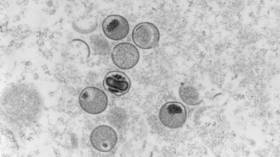Top health official comments on how monkeypox spreads

The monkeypox virus can spread through the air, but only if “close, sustained face-to-face contact” is maintained, the director of the US Centers for Disease Control and Prevention (CDC) told reporters on Friday.
With the disease spreading predominantly among gay men, СDС Director Rochelle Walensky, cautioned doctors not to mistake it for more common sexually transmitted diseases.
Monkeypox is similar to human smallpox, and is endemic in parts of West and Central Africa, where it can be caught from infected wild animals. However, outbreaks of the disease have been recorded in 28 World Health Organization (WHO) member states in recent weeks, and as of Wednesday, 1,285 cases have been confirmed in countries where monkeypox is usually not found, per WHO data.
With 45 cases recorded in the US, Walensky said during a briefing that monkeypox does not present the same risk of airborne transmission as Covid-19.
“Monkeypox is not thought to linger in the air and is not typically transmitted during short periods of shared airspace,” she said. “The virus is not thought to spread through interactions such as having a casual conversation, passing in the grocery store or touching the same items, such as a doorknob.”
Walensky added that while the virus can be spread through respiratory droplets during “close, sustained face-to-face contact,” it more typically “spreads through direct contact with bodily fluids or sores on the body of someone who has monkeypox,” or through contact with an infected person’s clothing or bedding.
The initial symptoms of monkeypox include fever, headache, muscle aches, backache, swollen lymph nodes, chills, and exhaustion. A rash often begins on the face and then spreads to other parts of the body, although the WHO has noted that patients affected by the current outbreak are developing lesions on the genitals and anus, and not developing some of the traditional flu-like symptoms of infection.
Initial cases in Europe last month were found almost entirely in gay and bisexual men, and this trend has continued. The CDC states that “gay, bisexual, and other men who have sex with men make up a high number of cases,” while the WHO notes that “cases have mainly, but not exclusively, been identified amongst men self-identified as part of extended sexual networks.”
Walensky also cautioned on Friday that monkeypox lesions can resemble those caused by herpes and syphilis, and stated that some monkeypox patients also had these diseases, as well as gonorrhea or chlamydia. “Health-care providers should not rule out monkeypox just because a patient has another diagnosis or another [Sexually Transmitted Infection],” she warned.
Department of Health and Human Services official Dawn O’Connell also told reporters on Friday that the US has purchased an additional 300,000 monkeypox vaccine doses, adding to its current stock of 72,000. The shot, manufactured by Bavarian Nordic and named Jynneos, was approved for use against smallpox and monkeypox by the US Food and Drug Administration in 2019, but has only been approved in Europe for immunizing against smallpox.
The WHO is not currently recommending mass vaccination against monkeypox.













